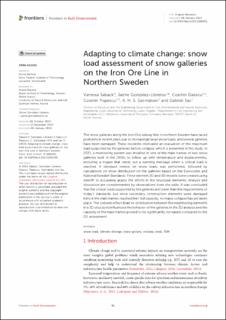| dc.contributor.author | Saback, Vanessa | |
| dc.contributor.author | Gonzalez-Libreros, Jaime | |
| dc.contributor.author | Daescu, Cosmin | |
| dc.contributor.author | Popescu, Cosmin | |
| dc.contributor.author | Garmabaki, A.H.S. | |
| dc.contributor.author | Sas, Gabriel | |
| dc.date.accessioned | 2024-02-08T09:06:56Z | |
| dc.date.available | 2024-02-08T09:06:56Z | |
| dc.date.created | 2024-02-02T09:45:11Z | |
| dc.date.issued | 2024 | |
| dc.identifier.citation | Frontiers in Built Environment. 2024, 9 . | |
| dc.identifier.issn | 2297-3362 | |
| dc.identifier.uri | https://hdl.handle.net/11250/3116306 | |
| dc.description.abstract | The snow galleries along the Iron Ore railway line in Northern Sweden have faced problems in recent years due to increasingly large snow loads, and several galleries have been damaged. These incidents motivated an evaluation of the maximum load supported by the galleries before collapse, which is presented in this study. In 2021, a monitoring system was installed in one of the main frames of two snow galleries built in the 1950s to follow up with temperature and displacements, including a trigger that sends out a warning message when a critical load is reached. A literature review on snow loads was performed, followed by calculations on snow distribution on the galleries based on the Eurocodes and National Swedish Standards. Finite element 2D and 3D models were created using AxisVM to accurately assess the efforts in the structural elements. Analysis and discussion are complemented by observations from site visits. It was concluded that the critical loads supported by the galleries are lower than the requirements of today’s standards, but since secondary construction elements were damaged before the main frames reached their full capacity, no major collapse has yet taken place. The cobweb effect (load re-distribution between the neighboring elements in a 3D structure) influenced the behavior of the galleries in the 3D analysis and the capacity of the main frames proved to be significantly increased compared to the 2D assessment. | |
| dc.language.iso | eng | |
| dc.subject | Snow gallery | |
| dc.subject | Snow gallery | |
| dc.subject | Snow load | |
| dc.subject | Snow load | |
| dc.subject | Climate change | |
| dc.subject | Klimaendringer | |
| dc.subject | Railway | |
| dc.subject | Railway | |
| dc.title | Adapting to climate change: snow load assessment of snow galleries on the Iron Ore Line in Northern Sweden | |
| dc.title.alternative | Adapting to climate change: snow load assessment of snow galleries on the Iron Ore Line in Northern Sweden | |
| dc.type | Peer reviewed | |
| dc.type | Journal article | |
| dc.description.version | publishedVersion | |
| dc.subject.nsi | VDP::Teknologi: 500 | |
| dc.subject.nsi | VDP::Technology: 500 | |
| dc.source.pagenumber | 21 | |
| dc.source.volume | 9 | |
| dc.source.journal | Frontiers in Built Environment | |
| dc.identifier.doi | 10.3389/fbuil.2023.1308401 | |
| dc.identifier.cristin | 2242436 | |
| dc.relation.project | Andre: Sveriges meteorologiska och hydrologiska institut (SMHI) | |
| dc.relation.project | Andre: Luleå Railway Research Center (JVTC) | |
| dc.relation.project | Andre: Trafikverket, Sverige | |
| dc.relation.project | EU/Interreg Aurora, the SCABEAC project | |
| cristin.ispublished | true | |
| cristin.fulltext | original | |
| cristin.qualitycode | 1 | |
